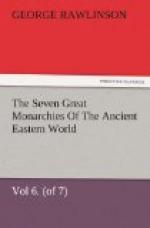It has been already noticed that Mithridates appears to have been the first Parthian sovereign who took the title of “King of Kings.” The title had been a favorite one with the old Assyrian and Persian monarchs, but was not adopted either by the Seleucidae or by the Greek kings of Bactria. Its revival implied a distinct pretension to that mastery of Western Asia which had belonged of old to the Assyrians and Persians, and which was, in later times, formally claimed by Artaxerxes, the son of Sassan, the founder of the New Persian Kingdom. Previous Parthian monarchs had been content to call themselves “the King,” or “the Great King”—Mithridates is “the King of Kings, the great and illustrious Arsaces.”
At the same time Mithridates appears to have assumed the tiara, or tall stiff crown, which, with certain modifications in its shape, had been the mark of sovereignty, both under the Assyrians and under the Persians. Previously the royal headdress had been either a mere cap of a Scythic type, but lower than the Scyths commonly wore it; or the ordinary diadem, which was a band round the head terminating in two long ribbons or ends, that hung down behind the head on the back. According to Herodian, the diadem, in the later times, was double; but the coins of Parthia do not exhibit this peculiarity. [Plate 1, Fig. 4.]
Ammianus says that among the titles assumed by the Parthian monarchs was that of “Brother of the Sun and Moon.” It appears that something of a divine character was regarded as attaching to the race. In the civil contentions, which occur so frequently throughout the later history, combatants abstained from lifting their hands knowingly against an Arsacid, to kill or wound one being looked upon as sacrilege. The name of Deos was occasionally assumed, as it was in Syria; and more frequently kings took the epithet of [Greek], which implied the divinity of their father. After his death a monarch seems generally to have been the object of a qualified worship; statues were erected to him in the temples, where (apparently) they were associated with the images of the great luminaries.
Of the Parthian Court and its customs we have no account that is either complete or trustworthy. Some particulars, however, may be gathered of it on which we may place reliance. The best authorities are agreed that it was not stationary, but migrated at different times of the year to different cities of the Empire, in this resembling the Court of the Achaemenians. It is not quite clear, however, which were the cities thus honored. Ctesiphon was undoubtedly one of them. All writers agree that it was the chief city of the Empire, and the ordinary seat of the government. Here, according to Strabo, the kings passed the winter months, delighting in the excellence of the air. The town was situated on the left bank of the Tigris, opposite to Seleucia, twelve or thirteen miles below the modern Baghdad. Pliny says that it was built by the Parthians in order to reduce Seleucia to insignificance, and that when it failed of its purpose they built another city.




